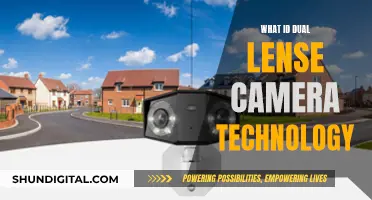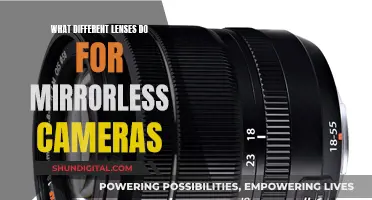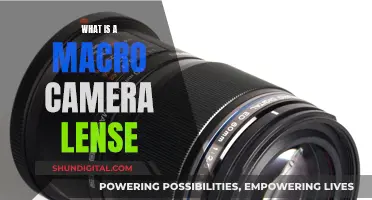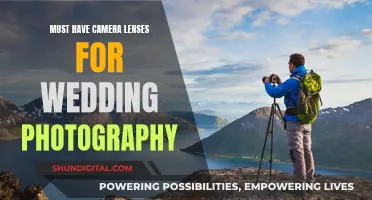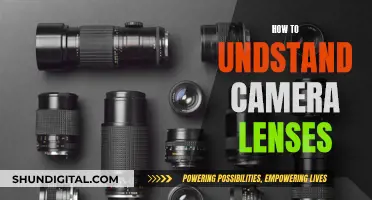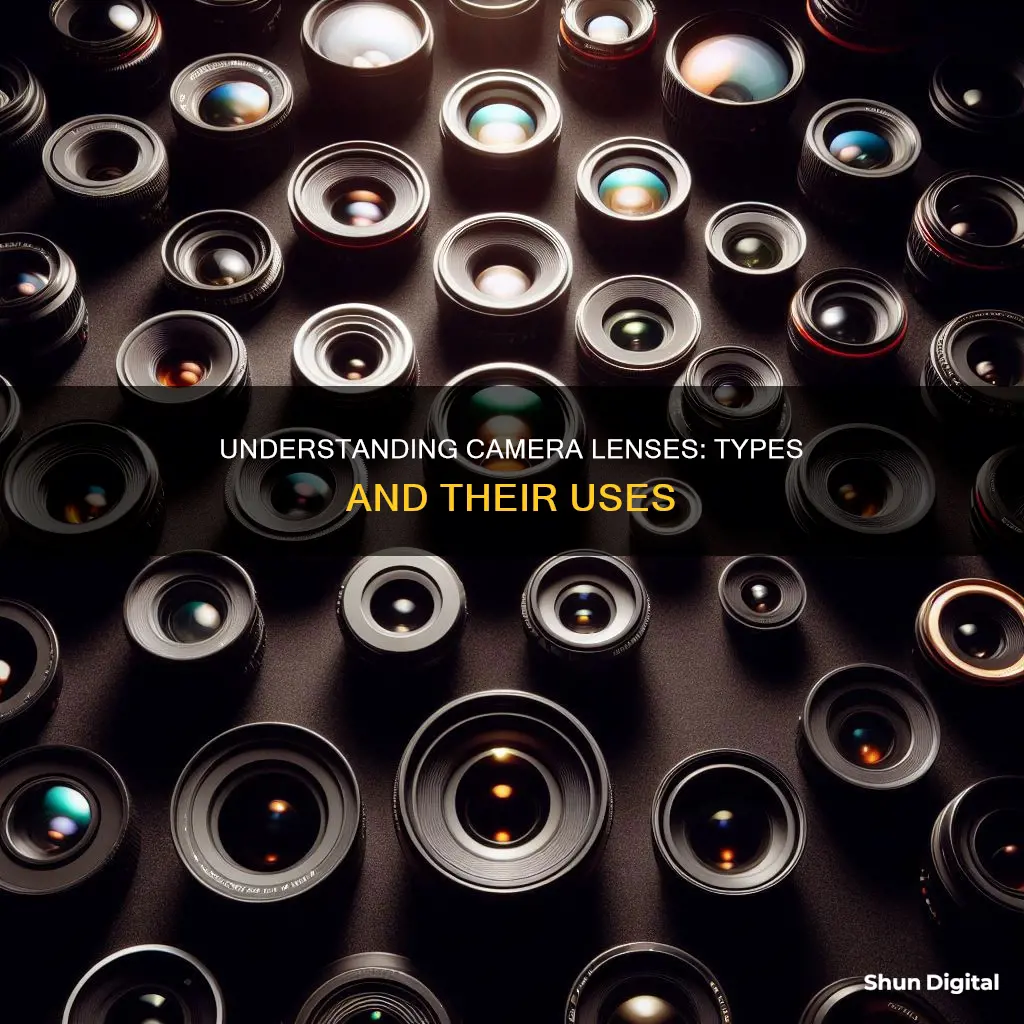
Camera lenses are essential for capturing sharp, detailed photos. There are many types of camera lenses, each with its unique characteristics and use cases. The type of lens you choose depends on your photography needs, budget, and lighting conditions. Here's an introduction to the most common types of camera lenses:
- Standard Lenses: These lenses have a mid-range focal length, typically between 35mm and 85mm, offering a similar perspective to the human eye. They are versatile and suitable for various photography genres, including street, portrait, and travel photography.
- Telephoto Lenses: With focal lengths starting at 85mm, telephoto lenses allow photographers to capture subjects from a distance. They are heavier and bulkier than standard lenses and are often used in sports, wildlife, and portrait photography.
- Wide-Angle Lenses: These lenses have a short focal length, usually ranging from 14mm to 35mm, providing a broader field of view. They are commonly used in architecture and landscape photography to capture more of the scene in a single shot.
- Fish-eye Lenses: Fish-eye lenses are a type of ultra-wide-angle lens with a focal length between 4mm and 14mm. They offer a unique perspective, distorting straight lines and creating a convex appearance in the image. Fish-eye lenses are often used in abstract photography.
- Macro Lenses: Macro lenses are designed for extreme close-up photography, capturing intricate details with accuracy. They have a 1:1 ratio, allowing photographers to reproduce life-size images of small subjects like insects, flowers, or jewellery.
- Tilt-Shift Lenses: These lenses can be tilted and shifted to manipulate the vanishing points and perspective of a scene. They are used in specialised fields like architecture and fine art photography to reduce lens distortion and create unique visual effects.
- Prime vs. Zoom Lenses: Prime lenses have a fixed focal length, offering superior optical quality and larger apertures. Zoom lenses, on the other hand, provide a range of focal lengths but tend to be heavier and more expensive.
- Fast vs. Slow Lenses: Fast lenses have wide apertures, performing well in low-light conditions, while slow lenses have narrower apertures and are better suited for bright environments.
| Characteristics | Values |
|---|---|
| Standard Lenses | Mid-range focal length, typically 35mm-85mm or 40mm-60mm. Can have a fixed focal length and wide aperture. |
| Telephoto Lenses | Long focal length, starting at 85mm. Can be categorised as "mid-range" (70mm-200mm) or "super-telephoto" (above 200mm). |
| Wide-Angle Lenses | Short focal length, anything below 40mm. Can be further classified as "wide" (20mm-35mm) or "ultra-wide" (below 20mm). |
| Fish-Eye Lenses | Focal length between 4mm-14mm or 8mm-24mm. |
| Macro Lenses | 1:1 ratio, capturing subjects at life-size magnification. Can have a focal length of 35mm-200mm. |
| Tilt-Shift Lenses | Can be tilted and shifted to manipulate the vanishing points of a scene. Typically range from 17mm-35mm. |
| Prime Lenses | Fixed focal length, better optical quality, wider aperture, lighter, and cheaper. |
| Zoom Lenses | Variable or fixed aperture, heavier, more expensive, and more flexible. |
What You'll Learn
- Standard lenses: 40-60mm focal length, similar to the human eye, good for landscapes and portraits
- Telephoto lenses: >60mm focal length, magnifies subjects, good for portraits and sports
- Wide-angle lenses: <40mm focal length, good for group photos and landscapes
- Macro lenses: 1:1 ratio, great for close-up photography of nature and objects
- Prime vs zoom lenses: Prime has fixed focal length, zoom offers more flexibility

Standard lenses: 40-60mm focal length, similar to the human eye, good for landscapes and portraits
Standard lenses are a must-have for any professional photographer. They have a mid-range focal length, usually between 35mm and 85mm, with 50mm being the most common focal length. This focal length will give you roughly the same field of view as the naked eye, with no distortion.
Standard lenses are great all-rounders as they closely mimic what we can see naturally, making them suitable for a wide range of photography subjects, including landscapes, portraits, street photography, and candid shots. They are also good for travel photography as they are usually not too big or heavy, making them easy to carry around.
The images produced by standard lenses appear more natural than those taken with other types of camera lenses. This is because they offer a fairly accurate representation of what the human eye sees, both in terms of visual angle and perspective. As a result, standard lenses are especially valuable in documentary projects such as street, portrait, and travel photography.
The standard lens is also known as the "normal lens". Any lens with a focal length between 40mm and 58mm will show things roughly as the human eye sees them. On a crop sensor camera, a normal lens is typically around 35mm, and any focal length between 28mm and 36mm will work.
A standard lens will not be the best choice for wide landscape shots or close-up sports photos, but if you only want one lens that can cover a full range of situations, a standard lens is your best bet.
Adapting EF Lenses to Mirrorless Cameras: A Guide
You may want to see also

Telephoto lenses: >60mm focal length, magnifies subjects, good for portraits and sports
Telephoto lenses are used in photography to capture subjects and objects that are far away. They are defined by their focal length, which is 60mm or longer.
Telephoto lenses are a great choice for portrait photography. They can make the subject appear slightly slimmer and provide a flattering, blurred background. This is achieved by the lens's ability to isolate the subject and create a shallow depth of field. The longer the lens, the more pronounced this effect will be.
Telephoto lenses are also useful for sports photography, as they allow the photographer to capture the action from a distance without having to move around too much. They are also very popular for wildlife photography, as they enable photographers to get close-up shots of animals without disturbing them.
Telephoto lenses are typically categorised into two types: medium telephoto, which usually ranges from 70mm to 200mm, and super-telephoto, which is any focal length over 200mm.
It's important to note that telephoto lenses can be quite heavy, especially the super-telephoto variety, so a tripod or monopod is often required to stabilise the camera.
Understanding Camera Lenses: Decoding the Specs
You may want to see also

Wide-angle lenses: <40mm focal length, good for group photos and landscapes
Wide-angle lenses are those with a focal length of 40mm, usually ranging from 14mm to 35mm. They are a staple in most landscape photographers' kits, allowing them to capture sweeping vistas and starry nights. They are also commonly used in architecture and real estate photography, as they make spaces feel more expansive and impressive.
The classic focal length that street photographers use is 35mm, as it approximates how you see the world with your naked eye. Wide-angle lenses are also well-suited for travel photography, as their short focal length gives you more versatility to capture a multitude of scenes.
One of the key benefits of wide-angle lenses is their ability to create a large depth of field, allowing photographers to capture shots where most of the scene is in focus. This makes them ideal for group photos, as they can capture more people in a single frame without excluding anyone.
Another advantage of wide-angle lenses is their lightweight and compact design, making them perfect for hiking and throwing in a backpack. They are also generally more affordable than other types of lenses, making them a great option for those starting out in photography.
However, it's important to note that wide-angle lenses can distort images, especially portraits. They can make nearby objects appear much larger, while objects at a moderate distance seem smaller and farther away. This exaggeration of relative size can be used creatively to make foreground objects more prominent and striking, but it can also be a drawback if not carefully controlled.
When using a wide-angle lens, it's essential to pay attention to the composition and arrangement of elements within the frame. With a larger field of view, there is more room for error in the details. It's crucial to have a clear, dominant subject, get as close as possible to the subject, and use leading lines to guide the viewer's eye.
Overall, wide-angle lenses are a versatile and essential tool for photographers, especially those specialising in landscapes, architecture, travel, or group photography.
Camera Lenses: Face Distortion and the Art of Photography
You may want to see also

Macro lenses: 1:1 ratio, great for close-up photography of nature and objects
Macro lenses are used for close-up photography and have a 1:1 ratio, meaning they can capture subjects at life-size magnification. This allows photographers to capture the tiniest details of small objects, such as insects, flowers, or water droplets. The 1:1 ratio is significant because it means the size of the subject is projected onto the sensor at the exact same size as in real life.
The unique internal structure of macro lenses allows them to capture close-ups with accurate detail, sharpness, and contrast. They have very short focusing distances and can produce sharp images of very small subjects. The minimum focus distance of a macro lens is usually around 30cm, allowing photographers to get extremely close to their subjects while still achieving a sharp focus.
While macro lenses are commonly associated with nature photography, they are also popular in other fields such as product photography and fine art photography. The ability to capture intricate details and textures makes macro lenses ideal for showcasing products, jewellery, or artwork.
In addition to their exceptional close-up capabilities, macro lenses also excel at portrait photography. The longer focal length and excellent sharpness of these lenses result in beautiful portraits with a dreamy background blur, making the subject stand out.
Macro lenses typically have focal lengths ranging from 35mm to 200mm. Photographers often prefer telephoto lengths as being farther from the subject makes it easier to illuminate the scene and compose the shot. It's important to note that macro lenses are not designed for long-distance photography and perform poorly in such scenarios. They are purpose-built for close-up work, allowing photographers to explore the minute details of the world around them.
The Truth About Camera Lenses: Glass or Plastic?
You may want to see also

Prime vs zoom lenses: Prime has fixed focal length, zoom offers more flexibility
There are two main types of camera lenses: prime lenses and zoom lenses. Prime lenses have a fixed focal length, while zoom lenses offer a range of focal lengths.
Prime Lenses
Prime lenses have a single focal length, such as 35mm, 50mm, or 85mm. They cannot zoom in or out, so photographers must physically move closer or farther from their subject to change the composition of their shot. Prime lenses tend to be cheaper, lighter, and optically superior to zoom lenses. They also typically produce sharper images and perform better in low-light conditions due to their wider apertures.
Zoom Lenses
Zoom lenses, on the other hand, offer a variable focal length, allowing photographers to change the angle of view without moving. For example, a zoom lens with a 24-105mm range can function as a wide-angle, normal, and telephoto lens all in one. Zoom lenses are highly versatile and convenient, especially for photographers who need to adapt to various situations. They are heavier and more expensive than prime lenses, but modern zoom lenses are impressively sharp and often feature effective image stabilization systems.
Choosing Between Prime and Zoom Lenses
The choice between a prime and a zoom lens depends on the photographer's needs and preferences. Prime lenses are ideal for achieving very shallow depths of field and producing high-quality images, even in low light. Zoom lenses excel in versatility, image stabilization, and portability, making them a popular choice for videographers and wildlife photographers. Ultimately, both types of lenses have their strengths and weaknesses, and many photographers end up using a combination of both depending on the specific requirements of their projects.
Understanding Millimeters in Canon Camera Lenses
You may want to see also
Frequently asked questions
There are several types of camera lenses, each with its own unique characteristics and use cases. The most common types include standard lenses, telephoto lenses, wide-angle lenses, macro lenses, and prime lenses.
Standard lenses have a mid-range focal length, typically between 35mm and 85mm, offering a similar perspective to the human eye. They are versatile and suitable for various photography genres, including landscapes, portraits, and street photography.
Telephoto lenses have long focal lengths, usually starting at 85mm, and offer magnification for photographing distant subjects. They are commonly used in wildlife, sports, and portrait photography.
Wide-angle lenses have short focal lengths, typically ranging from 14mm to 35mm, allowing photographers to capture more of the scene in a single frame. They are popular for architecture and landscape photography.
Macro lenses are designed for extreme close-up photography, often used to capture intricate details of small subjects like insects, flowers, or products. They have a 1:1 ratio, reproducing life-size or larger-than-life images with excellent sharpness and contrast.
Prime lenses have a fixed focal length and do not zoom. They typically offer wider apertures, making them ideal for low-light photography and creating background blur. Prime lenses are commonly used in street, portraits, and landscape photography.


